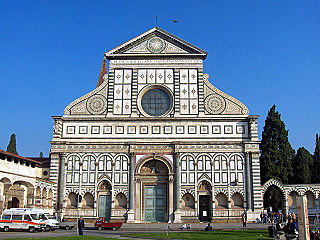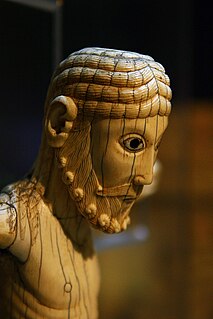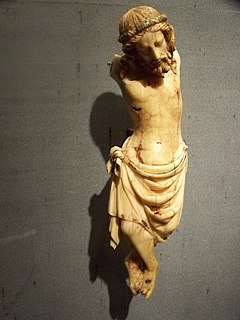 W
WA crucifix is an image of Jesus on the cross, as distinct from a bare cross. The representation of Jesus himself on the cross is referred to in English as the corpus.
 W
WThe Basilica del Santo Crucifix is a 1444-1447 bronze sculpture by Donatello on the high altar of the basilica di Sant'Antonio da Padova in Padua. It measures 180 by 166 cm - his only monumental bronze on that scale prior to that date had been his 1423-1425 Saint Louis of Toulouse. The work was originally nude, with a textile loincloth probably intended to be added - the current bronze one is a Baroque addition. The work also marks a development away from the exaggerated realism of his youthful Santa Croce Crucifix.
 W
WThe Batlló Majesty is a large 12th-century Romanesque wooden crucifix, now in the National Art Museum of Catalonia in Barcelona, Spain. It is one of the most elaborate examples in Catalonia of an image of Christ on the Cross symbolizing his triumph over death.
 W
WThe Master of the Bigallo Crucifix (fl.1215/20-1265) was an Italian religious artist who ran one of the first fully organized workshops before Cimabue. His notname comes from a crucifix on wood which is displayed at the Museo del Bigallo in Florence.
 W
WThe Bocholt Cross is a forked crucifix in St. George's Church in Bocholt, in the German state of North Rhine-Westphalia and dates to the early 14th century. It is the oldest and most significant ornament of this church and the focal point of a regional pilgrimage today.
 W
WSanta Maria Novella is a church in Florence, Italy, situated opposite, and lending its name to, the city's main railway station. Chronologically, it is the first great basilica in Florence, and is the city's principal Dominican church.
 W
WThe Carrizo Christ is an 11th-century ivory carving and is conserved in the Museo de León, León (Spain). The figure is 13 inches (33 cm) high. The piece came from the Cistercian monastery of Santa María de Carrizo located some 16 miles west of León.
 W
WThe Coesfeld Cross is a forked crucifix and is located in the Church of Saint Lambert in Coesfeld.
 W
WThe Crucified Christ is a sculpture in walrus ivory, probably from Paris c 1300, now in The Cloisters, New York. It is lined with traces of paint and gilding. Although small in scale, it is structured in a monumental style. It shows the dead and crucified body of Christ; in the 12th century the dead Christ was widely seen as representing human suffering. This work is noted for its high quality craftsmanship, and the subtle and sensitive rendering of the torso. The stunted legs are a notable and somewhat inexplicable feature.
 W
WThe crucifix of Ferdinand and Sancha is an ivory carving from circa 1063, today in the National Archaeological Museum of Spain. It was part of an offering by King Ferdinand I of León and Queen Sancha to furnish the basilica of San Isidoro de León. It is the earliest known crucifix from Spain depicting the body of Christ. Although earlier Spanish crucifixes of gold, ivory and wood are known, they are all without images. The official inventory of the royal gift describes the crucifix as "a cross of ivory with the image of our crucified Redeemer". It measures 52 cm high, 34.5 cm wide, and 1 cm thick, with the width of the cross beams being 7 cm. The image of Christ is 305 mm tall.
 W
WThe crucifix of San Marcello is a medieval work of religious art that is venerated in the Oratory of Santissimo Crocifisso of the Church of San Marcello al Corso in Rome. Having survived a fire that destroyed the church in 1519, the crucifix was popularly believed to possess intercessory powers. During an epidemic of plague in 1522 the crucifix was carried in a procession through the city. According to popular belief at the time, the procession caused the plague to leave the neighborhoods through which the crucifix passed, and eventually to die out in Rome.
 W
WThis 1599 crucifix by Spanish artist Gaspar Núñez Delgado is located in the Indianapolis Museum of Art, which is in Indianapolis, Indiana. Made of ivory, ebony, mahogany, silver, and polychromy, it displays Núñez Delgado's mastery of human anatomy and human pain.
 W
WThe Gero Cross or Gero Crucifix, of around 965–970, is the oldest large sculpture of the crucified Christ north of the Alps, and has always been displayed in Cologne Cathedral in Germany. It was commissioned by Gero, Archbishop of Cologne, who died in 976, thus providing a terminus ante quem for the work. It is carved in oak, and painted and partially gilded – both have been renewed. The halo and cross-pieces are original, but the Baroque surround was added in 1683. The figure is 187 cm high, and the span of its arms is 165 cm.
 W
WThe Head of Christ from the Crooked or Brown Cross is a sculpted head of Christ, the only remaining part of one of the most worshipped crucifixes in Leuven, Belgium. It played an important role in the city's history. The head is found in St. Peter's Church in Leuven.
 W
WThe Holy Face of Lucca is an eight-foot-tall (2.4 m), ancient wooden carving of Christ crucified in Lucca, Italy. Medieval legends state that it was sculpted by Nicodemus who assisted St. Joseph of Arimathea in placing Christ in his tomb after the crucifixion. The same legends placed its miraculous arrival in Lucca to AD 782.
 W
WOur Lord of the Miracles of Buga, also known as the Lord of the Miracles, is a famous statue of Jesus Christ in the form of a crucifix, remarkable for having come into existence miraculously and spontaneously and without the work of human hands. This type of miraculous icon is known as acheiropoieta.
 W
WTwo different crucifixes, or strictly, wooden corpus figures for crucifixes, are attributed to the High Renaissance master Michelangelo, although neither is universally accepted as his. Both are relatively small figures which would have been produced in Michelangelo's youth.
 W
WThe Padua Crucifix is a painting of c. 1303–1305 in tempera on poplar panel by Giotto. Originally hanging in the centre of the Scrovegni Chapel in Padua, above the latticework of the iconostasis, it was probably contemporaneous with his frescoes in the same chapel. It now hangs in the Musei degli Eremitani in Padua.
 W
WThe Perugia Crucifix is a gold and tempera on panel painted crucifix of the Christus patiens type. It is dated to 1272 thanks to an inscription on its base reading "ANNO DOMINI MCCLXXII TEMPORE GREGORI P.P.X.. It is now in the Galleria nazionale dell'Umbria.
 W
WThe Premyslid Crucifix from Jihlava. The Premyslid Crucifix is a polychromed wooden cross dating from the first half of the 14th century. It is on display at the Picture Gallery of Strahov Monastery in Prague. In 2010 it was declared a National Cultural Monument by the Czech government.
 W
WThe Santa Croce Crucifix is a c.1406-1408 polychrome wood sculpture by Donatello, then a young artist just back from Rome. It is in the Cappella Bardi di Vernio just off the left transept of Santa Croce in Florence, Italy.
 W
WThe Sejm cross is a Catholic crucifix in the building of the Sejm of the Republic of Poland, the lower house of the Polish parliament.